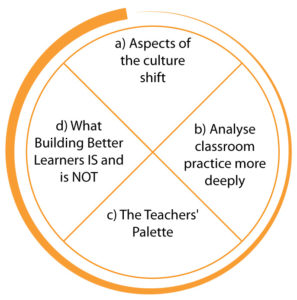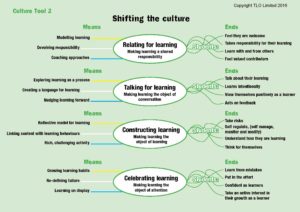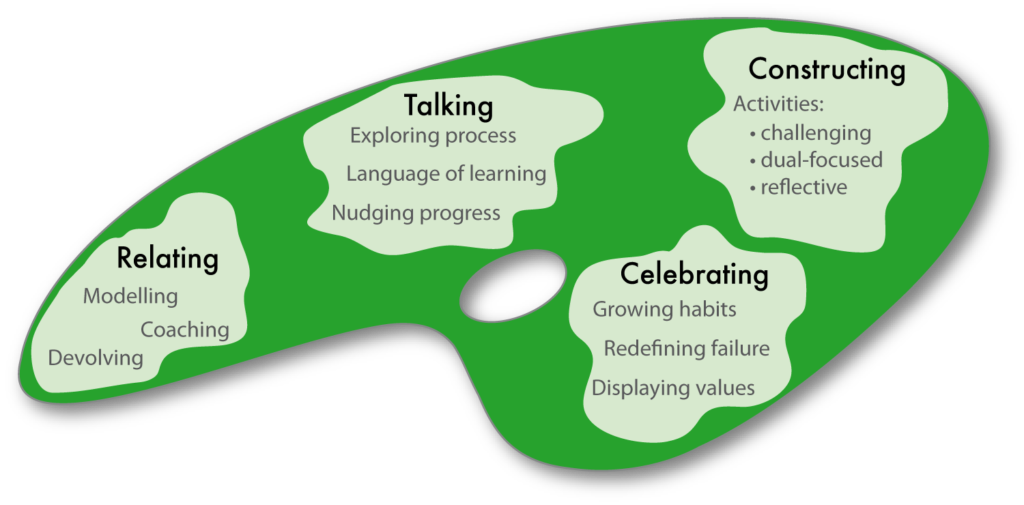Making the journey from teacher to learning centred cultures is a gradual, sometimes difficult, but hugely worthwhile process of culture change by the school and habit change by teachers. Building Better Learners is essentially about making that journey in order to systematically cultivate pupils’ supple learning mind.
This section explores what is entailed in shifting from the dominant teacher culture to the richer learning culture.

Which aspect of classroom culture needs most attention in your school?
a) Aspects of the culture shift
In broad terms the teachers’ role becomes one of surfacing the learning; making it public; making it visible to the learner; making pupils aware of their learning behaviours, thoughts and feelings. In so doing the strategic emphasis of the classroom shifts;
- from performance ⟹ learning.
- from content ⟹ process.
- from teaching ⟹ coaching
And in order to make these strategic shifts there are four inter-related aspects of teacher behaviour to work on. The precise details of the four aspects will be different for every teacher in every school.

Gradual and worthwhile change
1. Relating for learning is about:
- Learning becoming a shared responsibility
- Pupils being given more responsibility for their own learning
- The teacher becoming the learning coach; enabling pupils to find their own ways to improve
- Collaborative activity that helps pupils to see each other as resources for learning
- Pupils being given choices about what and how to learn
- Pupils talking more, adults talking less
- Teachers modelling being a learner
- Processes promoting, enabling and supporting the best of what we know about learning.

Sharing responsibility for learning
2. Talking for learning is about:
- Learning, rather than performance, becoming the object of conversation
- The gradual introduction of a learning language helping pupils to become conscious of using their learning behaviours
- Using and extending the language; adding breadth and depth to how teachers and learners talk about, understand and improve learning.
- Pupils being encouraged to notice things about how they are learning, talking about the learning process and becoming a meta-learner.
The language of learning revolves around a set of high value psychological characteristics to develop a supple learning mind. These include emotional, cognitive, social and strategic characteristics. These characteristics are unpacked in Section 2.

Talking about the learning process
3. Constructing learning is about:
- Learning, rather than performance, being made the object of learning.
- Reflecting on learning and reviewing learning being built into the learning model used in the classroom
- Learning activities being designed to stretch and challenge – by having a dual focus to explore content and stretch pupils’ ability to use their learning behaviours.
- Teachers making conscious choices about which habits/learning behaviours to introduce and stretch and how best to couple these with content so that lessons become more interesting and challenging.
- A third dimension being added to teaching: 1. Subject matter, 2. Assessment 3. The learning behaviours being used in order to learn.

Blending content with learning process. The what and how.
4. Celebrating learning is about:
- Learning, rather than performance, being made the object of attention
- The underlying values about learning becoming visible through what is recognised, praised, displayed. For example:-
- Being stuck being recognised as an interesting – not shameful – place to be.
- Mistakes being recognised as invaluable in learning.
- Effort being unpacked to show how it is channelled.
- Good questions being as important as good answers.
- Using learning behaviours more often and more skilfully being nudged and recognised
- So the growth of learning habits is being attended to closely.

The how of learning is closely attended to.
Putting better learning into classrooms
Listen to what the originator of Building Learning Power has to say about what the culture change in schools and the habit change by teachers might look like
b) Analyse classroom practice more deeply
- Download the deeper Learning Culture Tool 2.
- Look carefully at the Culture Tool 2 in relation to your school.
- Ring the MEANS statements that describe aspects of the school culture that you think are secure.
- Underline those statements that would most benefit your pupils now.
Thinking more deeply about classroom cultures in your school. Asking hard questions.

- How many of these MEANS are in use in classrooms?
- How much is learning externalised or surfaced?
- What’s the balance between telling and coaching in classrooms?
- Do pupils have any language to talk about their learning?
- What proportion of tasks would you estimate to be rich and challenging?
c) The Teachers’ Palette
The thinking and research of Chris Watkins, Guy Claxton and others have influenced the models and diagrams above. We have distilled this into the new Teachers’ Palette. The Teachers’ Palette depicts an action packed framework of the types of actions teachers need to take in order to create the conditions necessary for learning behaviours to be habituated.
Those of you who have read and absorbed the original book Building Learning Power by Guy Claxton will notice the palette has now turned green. Thinking has moved on since Building Learning Power was introduced in 2002, many schools have become more performance focused, curriculums have become overloaded and with more difficult content, teachers have been put under greater administrative strain and so forth. Hence the green palette takes on the uncomfortable truth that classrooms, in many schools, have become more teacher focused and pupils are being given less responsibility for their learning. The journey to learning centred classrooms now has more hurdles to overcome
Modules 3.2 to 3.5 explore each of these cultural aspects in turn, suggesting first steps on the journey towards building better learners.

d) What Building Better Learners IS and is NOT
It’s not:
- a short-term, quick fix for classroom practice
- about little tweaks to the how of teaching
- about having pupils just saying “I can’t do this yet”
- about pupils just being able to say ‘collaboration’ or ‘resilience’ without knowing what and how and when
- pupils ‘doing’ learning power
- about teachers knowing a bit more about learning
- about pupils simply knowing the names of learning behaviours
- just about what happens in classrooms (see Section 5 for detail)
- simply offering pupils harder learning activities
- something we can do in a year
- an initiative
It is about:
- pupils developing long term learning habits to stand them in good stead for a complex world
- young people becoming better learners (independent, self-regulating, flexible)
- learners having the skills to flourish in uncertain times
- a way of educating which has learning at its heart
- classrooms becoming learning labs; schools becoming learning organisations
- classroom cultures becoming learning-friendly
- teachers using a forensic and precise understanding of learning in order to grow supple learning minds
- teachers becoming learning coaches
- a shift that will take most schools about 3 years
- a bigger game of education



Comments are closed.